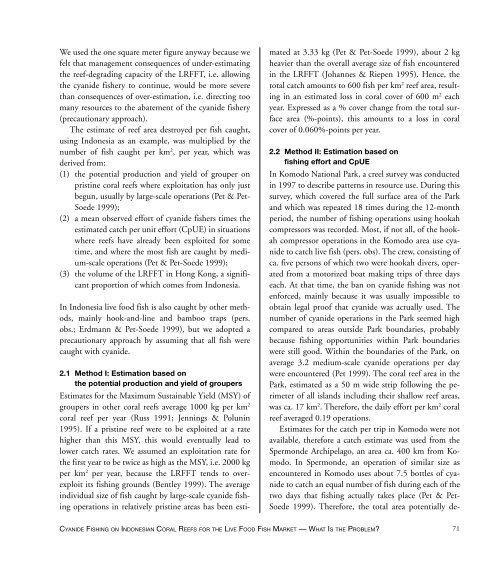You also want an ePaper? Increase the reach of your titles
YUMPU automatically turns print PDFs into web optimized ePapers that Google loves.
We used the one square meter figure anyway because we<br />
felt that management consequences <strong>of</strong> under-estimating<br />
the reef-degrading capacity <strong>of</strong> the LRFFT, i.e. allowing<br />
the cyanide fishery to continue, would be more severe<br />
than consequences <strong>of</strong> over-estimation, i.e. directing too<br />
many resources to the abatement <strong>of</strong> the cyanide fishery<br />
(precautionary approach).<br />
The estimate <strong>of</strong> reef area destroyed per fish caught,<br />
using Indonesia as an example, was multiplied by the<br />
number <strong>of</strong> fish caught per km 2 , per year, which was<br />
derived from:<br />
(1) the potential production and yield <strong>of</strong> grouper on<br />
pristine coral reefs where exploitation has only just<br />
begun, usually by large-scale operations (Pet & Pet-<br />
Soede 1999);<br />
(2) a mean observed effort <strong>of</strong> cyanide fishers times the<br />
estimated catch per unit effort (CpUE) in situations<br />
where reefs have already been exploited for some<br />
time, and where the most fish are caught by medium-scale<br />
operations (Pet & Pet-Soede 1999);<br />
(3) the volume <strong>of</strong> the LRFFT in Hong Kong, a significant<br />
proportion <strong>of</strong> which comes from Indonesia.<br />
In Indonesia live food fish is also caught by other methods,<br />
mainly hook-and-line and bamboo traps (pers.<br />
obs.; Erdmann & Pet-Soede 1999), but we adopted a<br />
precautionary approach by assuming that all fish were<br />
caught with cyanide.<br />
2.1 Method I: Estimation based on<br />
the potential production and yield <strong>of</strong> groupers<br />
Estimates for the Maximum Sustainable Yield (MSY) <strong>of</strong><br />
groupers in other coral reefs average 1000 kg per km 2<br />
coral reef per year (Russ 1991; Jennings & Polunin<br />
1995). If a pristine reef were to be exploited at a rate<br />
higher than this MSY, this would eventually lead to<br />
lower catch rates. We assumed an exploitation rate for<br />
the first year to be twice as high as the MSY, i.e. 2000 kg<br />
per km 2 per year, because the LRFFT tends to overexploit<br />
its fishing grounds (Bentley 1999). The average<br />
individual size <strong>of</strong> fish caught by large-scale cyanide fishing<br />
operations in relatively pristine areas has been estimated<br />
at 3.33 kg (Pet & Pet-Soede 1999), about 2 kg<br />
heavier than the overall average size <strong>of</strong> fish encountered<br />
in the LRFFT (Johannes & Riepen 1995). Hence, the<br />
total catch amounts to 600 fish per km 2 reef area, resulting<br />
in an estimated loss in coral cover <strong>of</strong> 600 m 2 each<br />
year. Expressed as a % cover change from the total surface<br />
area (%-points), this amounts to a loss in coral<br />
cover <strong>of</strong> 0.060%-points per year.<br />
2.2 Method II: Estimation based on<br />
fishing effort and CpUE<br />
In Komodo National Park, a creel survey was conducted<br />
in 1997 to describe patterns in resource use. During this<br />
survey, which covered the full surface area <strong>of</strong> the Park<br />
and which was repeated 18 times during the 12-month<br />
period, the number <strong>of</strong> fishing operations using hookah<br />
compressors was recorded. Most, if not all, <strong>of</strong> the hookah<br />
compressor operations in the Komodo area use cyanide<br />
to catch live fish (pers. obs). The crew, consisting <strong>of</strong><br />
ca. five persons <strong>of</strong> which two were hookah divers, operated<br />
from a motorized boat making trips <strong>of</strong> three days<br />
each. At that time, the ban on cyanide fishing was not<br />
enforced, mainly because it was usually impossible to<br />
obtain legal pro<strong>of</strong> that cyanide was actually used. The<br />
number <strong>of</strong> cyanide operations in the Park seemed high<br />
compared to areas outside Park boundaries, probably<br />
because fishing opportunities within Park boundaries<br />
were still good. Within the boundaries <strong>of</strong> the Park, on<br />
average 3.2 medium-scale cyanide operations per day<br />
were encountered (Pet 1999). The coral reef area in the<br />
Park, estimated as a 50 m wide strip following the perimeter<br />
<strong>of</strong> all islands including their shallow reef areas,<br />
was ca. 17 km 2 . Therefore, the daily effort per km 2 coral<br />
reef averaged 0.19 operations.<br />
Estimates for the catch per trip in Komodo were not<br />
available, therefore a catch estimate was used from the<br />
Spermonde Archipelago, an area ca. 400 km from Komodo.<br />
In Spermonde, an operation <strong>of</strong> similar size as<br />
encountered in Komodo uses about 7.5 bottles <strong>of</strong> cyanide<br />
to catch an equal number <strong>of</strong> fish during each <strong>of</strong> the<br />
two days that fishing actually takes place (Pet & Pet-<br />
Soede 1999). Therefore, the total area potentially de-<br />
CYANIDE FISHING ON INDONESIAN CORAL REEFS FOR THE LIVE FOOD FISH MARKET — WHAT IS THE PROBLEM<br />
71


















